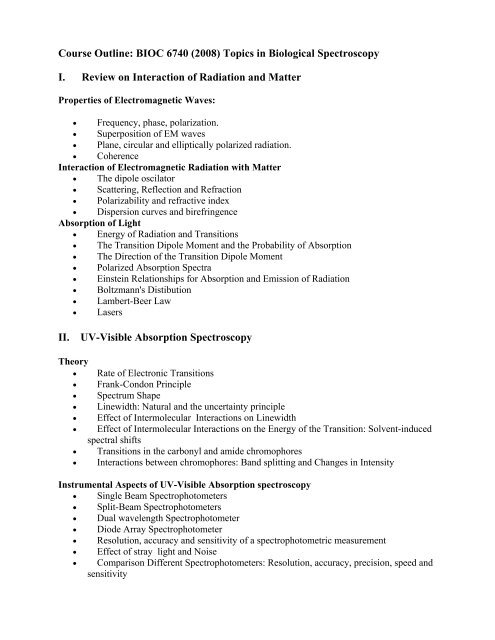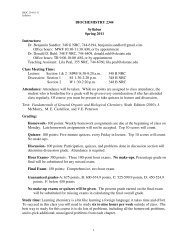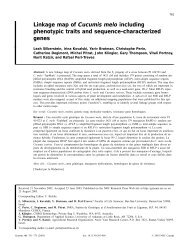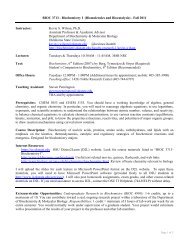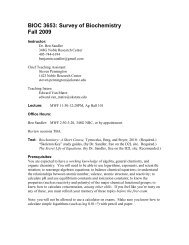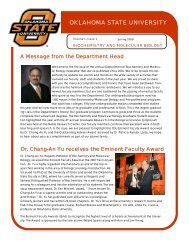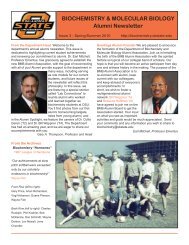BIOC 6740 - Biochemistry and Molecular Biology
BIOC 6740 - Biochemistry and Molecular Biology
BIOC 6740 - Biochemistry and Molecular Biology
You also want an ePaper? Increase the reach of your titles
YUMPU automatically turns print PDFs into web optimized ePapers that Google loves.
Course Outline: <strong>BIOC</strong> <strong>6740</strong> (2008) Topics in Biological Spectroscopy<br />
I. Review on Interaction of Radiation <strong>and</strong> Matter<br />
Properties of Electromagnetic Waves:<br />
• Frequency, phase, polarization.<br />
• Superposition of EM waves<br />
• Plane, circular <strong>and</strong> elliptically polarized radiation.<br />
• Coherence<br />
Interaction of Electromagnetic Radiation with Matter<br />
• The dipole oscilator<br />
• Scattering, Reflection <strong>and</strong> Refraction<br />
• Polarizability <strong>and</strong> refractive index<br />
• Dispersion curves <strong>and</strong> birefringence<br />
Absorption of Light<br />
• Energy of Radiation <strong>and</strong> Transitions<br />
• The Transition Dipole Moment <strong>and</strong> the Probability of Absorption<br />
• The Direction of the Transition Dipole Moment<br />
• Polarized Absorption Spectra<br />
• Einstein Relationships for Absorption <strong>and</strong> Emission of Radiation<br />
• Boltzmann's Distibution<br />
• Lambert-Beer Law<br />
• Lasers<br />
II. UV-Visible Absorption Spectroscopy<br />
Theory<br />
• Rate of Electronic Transitions<br />
• Frank-Condon Principle<br />
• Spectrum Shape<br />
• Linewidth: Natural <strong>and</strong> the uncertainty principle<br />
• Effect of Intermolecular Interactions on Linewidth<br />
• Effect of Intermolecular Interactions on the Energy of the Transition: Solvent-induced<br />
spectral shifts<br />
• Transitions in the carbonyl <strong>and</strong> amide chromophores<br />
• Interactions between chromophores: B<strong>and</strong> splitting <strong>and</strong> Changes in Intensity<br />
Instrumental Aspects of UV-Visible Absorption spectroscopy<br />
• Single Beam Spectrophotometers<br />
• Split-Beam Spectrophotometers<br />
• Dual wavelength Spectrophotometer<br />
• Diode Array Spectrophotometer<br />
• Resolution, accuracy <strong>and</strong> sensitivity of a spectrophotometric measurement<br />
• Effect of stray light <strong>and</strong> Noise<br />
• Comparison Different Spectrophotometers: Resolution, accuracy, precision, speed <strong>and</strong><br />
sensitivity
Analytical Methods used in UV-Visible Absorption Spectroscopy<br />
• Sample: preparation <strong>and</strong> stability<br />
• Selection of cuvette<br />
• Temperature control: effect on pH<br />
• Single Wavelength determination of concentrations<br />
• Multi-component samples <strong>and</strong> the use of Multiple wavelengths<br />
• Isosbestic Points<br />
• UV absorption Spectra of Proteins <strong>and</strong> chromophores of biological importance.<br />
• Difference Spectra<br />
• Derivative Spectroscopy.<br />
III. Fluorescence Spectroscopy<br />
1. Principles:<br />
• Jablonsky Diagram<br />
• Nonradiative Relaxation of Electronically Excited Molecules:<br />
Vibrational Relaxation <strong>and</strong> Internal Conversion.<br />
• Deactivation of the thermally-equilibrated lowest excited singlet state: radiative <strong>and</strong><br />
nonradiative processes<br />
• Fluorescence<br />
• Singlet-triplet Intersystem Crossing<br />
• Phosphorescence<br />
• Delayed Fluorescence.<br />
• Rates of Different Processes of Deactivation<br />
• Stokes Shift<br />
• Fluorescence Lifetime<br />
• Quantum Yields<br />
2. Steady-State Fluorescence Spectroscopy:<br />
• The steady-state spectrofluorometer.<br />
• Excitation <strong>and</strong> emission spectra: Acquisition <strong>and</strong> Corrections<br />
• Steady State Fluorescence Intensity:<br />
Effects of: quantum yield, absorbance, intensity of exciting radiation, <strong>and</strong> slit widths<br />
• Relationship between fluorophore concentration <strong>and</strong> fluorescence intensity<br />
Ideal Relationship, Inner Filter Effect<br />
• Experimental Considerations:<br />
Concentration of Fluorophores <strong>and</strong> Chromophores<br />
Scattering: Rayleigh <strong>and</strong> Raman<br />
Selecting the Excitation Wavelength<br />
Sensitivity of fluorescence: comparison with UV absorption techniques.<br />
3. Fluorescence in Proteins<br />
Most common Fluorophores: Phe, Tyr <strong>and</strong> Trp<br />
Applications to study environment of fluorophores<br />
Position of Maximum <strong>and</strong> Quantum Yields<br />
Effect of pH, denaturants <strong>and</strong> Environment
4. Fluorescence Quenching:<br />
• Collisional Quenching: The Stern-Volmer Equation.<br />
• Steady State <strong>and</strong> Lifetime Studies of Solute Quenching<br />
• Static Quenching<br />
• Applications of quenching studies: Study of dynamic <strong>and</strong> structural properties of<br />
macromolecules, lig<strong>and</strong>-binding <strong>and</strong> lipid-protein interaction.<br />
5. Fluorescence Polarization:<br />
• Definition of Anisotropy <strong>and</strong> Polarization Ratio.<br />
• Photoselection;<br />
• The emission transition dipole moment<br />
• Anisotropy of Florescence<br />
• Depolarization by Orientation Dependent Absorption;<br />
• Depolarization by non-co-linearity between absorption <strong>and</strong> emission dipoles<br />
• Depolarization by <strong>Molecular</strong> Motions<br />
• Time Dependent Anisotropy of Fluorescence<br />
• Steady State Anisotropy of Fluorescence<br />
• Perrin’s equation;<br />
• Macromolecular size <strong>and</strong> shape;<br />
• Study of chromophore dynamics in membranes <strong>and</strong> proteins;<br />
• Studies on Lig<strong>and</strong>-Protein <strong>and</strong> protein-protein association<br />
• Experimental Considerations: The G-factor<br />
6. Resonance Energy Transfer:<br />
• Forster Theory<br />
• The overlap integral<br />
• The κ factor<br />
• Forster’s Distance<br />
• Applications: Measurements of intermolecular distances, protein-protein<br />
interaction, membrane-protein interactions, Lig<strong>and</strong>-binding, topology of membrane<br />
proteins, lipid-exchange between membranes <strong>and</strong> between proteins <strong>and</strong> membranes.<br />
7. Time-resolved Fluorescence Spectroscopy:<br />
• Why measuring a fluorescence lifetime?<br />
• Theory of Frequency-Domain fluorometry<br />
• Data Analysis.<br />
• Principle of frequency-domain measurements.<br />
• Instrumentation: Light modulator, cross-correlation, Frequency synthesizers <strong>and</strong> radio<br />
frequency amplifiers.<br />
• Applications of time resolved measurements in FRET <strong>and</strong> in quenching studies.<br />
• The measurement of Lifetimes-distributions using frequency-domain fluorometry<br />
VI. Some Biochemical Applications of UV-Absorption Spectroscopy<br />
• Protein folding: Stability <strong>and</strong> kinetics of folding,<br />
• Lig<strong>and</strong>-Binding: Experimental <strong>and</strong> theoretical approaches for single site <strong>and</strong> multiple<br />
equilibria.<br />
• DNA melting<br />
• Chromophore Environment


